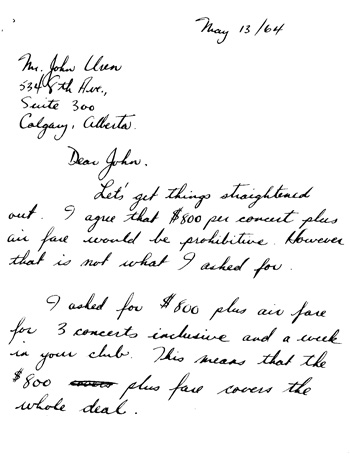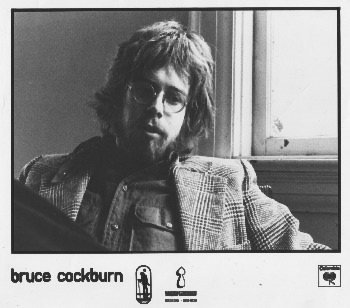| OUTLINE OF THE BOOK |
|
| 26. The Songwriters |
In 1962 Bob Dylan did with Blowin’ in the Wind what The
Kingston Trio had done 4 years before; he changed the rules of the
game. The folksinger as interpreter of traditional songs was replaced
by the singer-songwriter or the interpreter of the songs of the singer-songwriter. Ian and Sylvia, Gordon Lightfoot, Joni Mitchell, & Leonard Cohen met the test. Others didn’t. Folk music became stratified between amateurs,
local professionals and semi-professionals, and the “stars”. Increasingly folk singer and singer-songwriter were interchangeable. |
 Page 1, letter from Gordon Lightfoot to John Uren of the Depression coffee house in Calgary in May 1964. Outlines Lightfoot’s booking rate at the time and also mentions he will soon be signing with legendary NYC agent, Albert Grossman. Page 1, letter from Gordon Lightfoot to John Uren of the Depression coffee house in Calgary in May 1964. Outlines Lightfoot’s booking rate at the time and also mentions he will soon be signing with legendary NYC agent, Albert Grossman. |
 Page 2, letter from Gordon Lightfoot to John Uren of the Depression coffee house in Calgary in May 1964. Outlines Lightfoot’s booking rate at the time and also mentions he will soon be signing with legendary NYC agent, Albert Grossman. Page 2, letter from Gordon Lightfoot to John Uren of the Depression coffee house in Calgary in May 1964. Outlines Lightfoot’s booking rate at the time and also mentions he will soon be signing with legendary NYC agent, Albert Grossman. |
 Photo of folk singer-songwriter Gordon Lightfoot Photo of folk singer-songwriter Gordon Lightfoot |
 Photo of folk singer-songwriter Bruce Cockburn Photo of folk singer-songwriter Bruce Cockburn |
 Sam the Record Man ad for albums by Joni Mitchell (Song to a Seagull, and Clouds) and Neil Young (Neil Young, and Everybody Knows This Is Nowhere) as printed in the Mariposa Festival Program 1969 Sam the Record Man ad for albums by Joni Mitchell (Song to a Seagull, and Clouds) and Neil Young (Neil Young, and Everybody Knows This Is Nowhere) as printed in the Mariposa Festival Program 1969 |
 Poster advertising Duel, the Literary Magazine of Sir George Williams University, featuring an interview with Leonard Cohen, circa 1960s Poster advertising Duel, the Literary Magazine of Sir George Williams University, featuring an interview with Leonard Cohen, circa 1960s |
 Photo of Ian Tyson and Sylvia (Fricker) Tyson, as printed in Chatelaine Magazine, January 1964. page 22 Photo of Ian Tyson and Sylvia (Fricker) Tyson, as printed in Chatelaine Magazine, January 1964. page 22 |